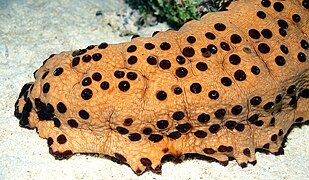Isostichopus badionotus
| Isostichopus badionotus | |
|---|---|

| |
| Scientific classification | |
| Domain: | Eukaryota |
| Kingdom: | Animalia |
| Phylum: | Echinodermata |
| Class: | Holothuroidea |
| Order: | Synallactida |
| Family: | Stichopodidae |
| Genus: | Isostichopus |
| Species: | I. badionotus
|
| Binomial name | |
| Isostichopus badionotus (Selenka, 1867)
| |
Isostichopus badionotus, also known as the chocolate chip cucumber or the cookie dough sea cucumber, is a species of sea cucumber in the family Stichopodidae. This common species is found in warm parts of the Atlantic Ocean.[1]
Description
This is a large species that can grow to a length of 45 cm (1 ft 6 in), but the average adult size is about 21 cm (8 in).[2] It has distinctive dark coloured "warts" in three coarse rows on its dorsal surface, the rest of the body may vary from white through to shades of orange to brown, with sometimes large brownish stains. The mouth is located ventrally and surrounded by about 20 large tentacles.
Habitat and range
This species is widespread in the warm Atlantic, where found from North Carolina (USA), through the Caribbean, to north Brazil, at Ascension Island and in the Gulf of Guinea.[1][2] It is found at depths between 0 and 55 m (0–180 ft).[1]
It inhabits shallow waters, in a wide variety of bottoms (sand, mud, rock, seaweeds...).[1]
Reproduction
Similar to other tropical Holothuroidea, the Isostichopus badiontus is dioecious. Males and females release their gametes into water where fertilization happens externally. A study in the Caribbean Sea observed that the species has an increase in reproductive activity when temperatures increase.[3]
Conservation status
As bottom feeders, Isostichopus badionotus individuals are threatened by contaminated substrates due to metals left behind by boats.[4] Additionally, they are popular in Asian cuisine, and are also threatened by illegal fishing and trafficking.[5] [6]
References
- ^ a b c d e Toral-Granda, M.V.; Alvarado, J.J.; Hamel, J.-F.; Mercier, A.; Benavides, M. & Paola Ortiz, E. (2016) [errata version of 2013 assessment]. "Isostichopus badionotus". IUCN Red List of Threatened Species. 2013: e.T180519A102420305. Retrieved 22 January 2021.
- ^ a b Steven W. Purcell, Yves Samyn and Chantal Conand, Commercially important sea cucumbers of the world, Roma, FAO Species Catalogue for Fishery Purposes Nb. 6, 2012, 233 p. (ISBN 978-92-5-106719-2).
- ^ Guzmán, H.; Guevara, C. & Hernández, I. (February 2003). "Reproductive cycle of two commercial species of sea cucumber (Echinodermata: Holothuroidea) from Caribbean Panama". Marine Biology. 142 (2): 271–279. doi:10.1007/s00227-002-0939-x. S2CID 86373107.
- ^ Rangel, Celia. "Isostichopus badionotus". Animal Diversity Web. Retrieved 2021-03-23.
- ^ Gore, Meredith L.; Bennett, Abigail (2021-02-18). "Importance of deepening integration of crime and conservation sciences". Conservation Biology. 36 (1): cobi.13710. doi:10.1111/cobi.13710. ISSN 0888-8892. PMC 9291754. PMID 33600003.
- ^ Gamboa-Álvarez, Miguel Ángel; López-Rocha, Jorge Alberto; Poot-López, Gaspar Román; Aguilar-Perera, Alfonso; Villegas-Hernández, Harold (2020-02-01). "Rise and decline of the sea cucumber fishery in Campeche Bank, Mexico". Ocean & Coastal Management. 184: 105011. doi:10.1016/j.ocecoaman.2019.105011. ISSN 0964-5691. S2CID 211343531.
External links
- Photos of Isostichopus badionotus on Sealife Collection



